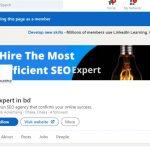LinkedIn is a powerful platform for professionals and businesses to connect, share knowledge, and generate leads. With over 740 million members, it offers a vast network of potential clients and partners. Here’s a comprehensive guide on how to generate leads from LinkedIn for free.
Essential Tips on How to Generate Leads from LinkedIn for Free
Generating leads on LinkedIn for free involves a combination of optimizing your profile, engaging with your network, sharing valuable content, and strategically using LinkedIn’s features. By building relationships and consistently providing value, you can attract and convert high-quality leads. Focus on being genuine, helpful, and strategic in your approach to see the best results.
Optimize Your LinkedIn Profile
Optimizing your LinkedIn profile is crucial for making a strong first impression and attracting potential leads. Here’s a step-by-step guide to help you enhance your LinkedIn profile:
Professional Headline and Profile Picture
Profile Picture
Professional Quality: Use a high-resolution, professional headshot. Dress appropriately for your industry.
Friendly Expression: Smile and appear approachable to create a positive impression.
Headline
Clear and Descriptive: Your headline should clearly state your role and the value you offer.
Keywords: Include relevant industry keywords to improve searchability.
Examples:
“Digital Marketing Expert | Helping Businesses Increase Online Visibility”
“Sales Consultant | Driving Revenue Growth through Strategic Partnerships”
Comprehensive Summary
Engaging Summary
First-Person Perspective: Write in the first person to make your summary personal and engaging.
Value Proposition: Clearly state what you do, who you help, and how you add value.
Keywords: Integrate industry-specific keywords naturally to enhance search visibility.
Call to Action: End with a call to action, such as inviting readers to connect or visit your website.
Example Summary:
“With over 10 years of experience in digital marketing, I specialize in creating data-driven strategies that increase online visibility and drive revenue growth. I help small to medium-sized businesses optimize their online presence through SEO, content marketing, and social media strategies. Let’s connect to see how we can collaborate and achieve your business goals.”
Detailed Experience
Professional Experience
Roles and Achievements: Clearly describe your roles, responsibilities, and achievements in each position.
Results-Oriented: Focus on quantifiable results and accomplishments, such as “Increased website traffic by 50% in six months through targeted SEO strategies.”
Keywords: Include relevant keywords in your job descriptions.
Example Experience:
Digital Marketing Manager, ABC Corp
Developed and implemented SEO strategies that increased organic search traffic by 50% within six months.
Led a team of five in creating and executing content marketing campaigns, resulting in a 30% increase in lead generation.
Managed social media accounts, boosting engagement rates by 25% through targeted campaigns.
Skills and Endorsements
Relevant Skills
Top Skills: List the top skills that are most relevant to your industry and expertise.
Endorsements: Seek endorsements from colleagues, clients, and partners to validate your skills.
How to Get Endorsements
Endorse Others: Endorse the skills of your connections, which often prompts them to return the favor.
Request Endorsements: Politely ask colleagues and clients to endorse your skills.
Recommendations
Request Recommendations
Strategic Requests: Ask for recommendations from clients, colleagues, and supervisors who can speak to your skills and achievements.
Specific Guidance: Provide specific guidance on what you’d like them to highlight.
Example Recommendation Request:
“Hi [Name], I’m updating my LinkedIn profile and would greatly appreciate a recommendation. Could you highlight the work we did on [specific project] and the results we achieved? Thank you!”
Accomplishments and Certifications
Showcase Accomplishments
Certifications: List relevant certifications to showcase your expertise and continuous learning.
Projects: Highlight significant projects you’ve worked on, detailing your role and the outcomes.
Publications: Include any articles, papers, or books you’ve published that demonstrate your thought leadership.
Example Certification:
“Google Analytics Certified”
Additional Sections
Volunteer Experience
Relevance: Include volunteer experiences that are relevant to your professional skills and industry.
Impact: Highlight the impact and outcomes of your volunteer work.
Example Volunteer Experience:
Volunteer Digital Marketing Consultant, Nonprofit XYZ
Developed and implemented a social media strategy that increased follower engagement by 40%.
Profile URL
Custom URL
Simplify Your URL: Customize your LinkedIn profile URL to make it clean and professional.
Example: https://www.linkedin.com/in/mustafa-sakib/
Contact Information
Accessible Contact Info
Email and Phone: Include your professional email address and phone number to make it easy for potential leads to contact you.
Website and Social Media: Add links to your professional website and other relevant social media profiles.
Build and Engage with Your Network
Building and engaging with your network on LinkedIn is essential for generating leads, enhancing your professional presence, and creating meaningful business relationships.
Connect with the Right People
Send connection requests to professionals in your industry, potential clients, and decision-makers. Personalize your connection requests to explain why you want to connect.
Participate in Groups
Join LinkedIn groups related to your industry. Engage in discussions, share insights, and provide value. Being active in groups positions you as a thought leader and attracts attention to your profile.
Engage with Content
Like, comment, and share posts from your connections and industry leaders. Meaningful engagement increases your visibility and shows your expertise.
Share Valuable Content
Sharing valuable content on LinkedIn is essential for building your professional brand, engaging with your network, and generating leads. Here are some tips on how to effectively share valuable content on LinkedIn:
Understand Your Audience
Identify Your Target Audience
Define Personas: Know who your ideal audience is, including their job roles, industries, interests, and pain points.
Relevant Content: Tailor your content to address the specific needs and challenges of your target audience.
Create High-Quality Content
Original Articles
Thought Leadership: Write in-depth articles that showcase your expertise and provide valuable insights.
How-To Guides: Share step-by-step guides that help your audience solve common problems.
Case Studies: Highlight successful projects or client work to demonstrate your skills and impact.
Short Posts
Tips and Tricks: Share quick tips, industry news, and updates relevant to your field.
Quotes and Insights: Post quotes from industry leaders or share your professional insights.
Visual Content
Images and Infographics: Use eye-catching visuals to convey information more engagingly.
Videos: Create short, informative videos or share behind-the-scenes content to humanize your brand.
Presentations: Upload presentations or slide decks on platforms like SlideShare and share them on LinkedIn.
Be Consistent and Regular
Posting Schedule
Frequency: Post regularly to stay top-of-mind with your audience. Aim for at least a few posts per week.
Timing: Experiment with posting times to see when your audience is most active.
Engage with Your Audience
Respond to Comments
Interaction: Respond to comments on your posts to foster engagement and build relationships.
Questions: Ask questions in your posts to encourage comments and interactions.
Share and Comment
Curate Content: Share relevant content from other industry experts and add your commentary.
Engage with Others: Like and comment on posts from your connections to increase your visibility and build rapport.
Utilize LinkedIn Features
LinkedIn Stories
Short Updates: Use LinkedIn Stories for quick updates, event highlights, or sharing day-to-day activities.
LinkedIn Polls
Engagement: Create polls to gather opinions, start discussions, and engage your audience in a fun and interactive way.
LinkedIn Live
Live Streaming: Host live sessions to interact with your audience in real-time. This can include Q&A sessions, webinars, or live discussions on trending topics.
LinkedIn Articles
In-Depth Content: Publish long-form articles directly on LinkedIn to reach a wider audience and establish yourself as a thought leader.
Leverage Hashtags and Mentions
Relevant Hashtags
Discoverability: Use relevant industry hashtags to increase the visibility of your posts.
Trending Hashtags: Participate in conversations around trending hashtags to reach a broader audience.
Mentions
Tag Influencers: Mention relevant influencers and connections in your posts to increase engagement and reach.
Collaborations: Collaborate with other professionals on content and tag them to leverage their network.
Analyze and Adjust
Monitor Performance
Analytics: Use LinkedIn’s analytics tools to track the performance of your posts, including views, likes, comments, and shares.
Insights: Analyze which types of content perform best and resonate most with your audience.
Adjust Strategy
Content Strategy: Based on your analysis, adjust your content strategy to focus more on what works and less on what doesn’t.
Continuous Improvement: Keep experimenting with different content formats, posting times, and engagement tactics.
Also Read
 LinkedIn Marketing Strategy
LinkedIn Marketing Strategy
 Lead Scoring and Qualification
Lead Scoring and Qualification
Leverage Advanced Search
Leveraging LinkedIn’s advanced search features is a powerful way to identify and connect with potential leads. Here’s a guide on how to use LinkedIn’s advanced search to generate high-quality leads:
Understand LinkedIn’s Search Filters
Basic Filters
Keywords: Search for specific keywords related to your industry or target market.
Connections: Filter by your 1st, 2nd, and 3rd-degree connections.
Locations: Narrow down results by specific geographic locations.
Current Companies: Search for people currently working at specific companies.
Industries: Filter results by specific industries to find relevant professionals.
Advanced Filters (LinkedIn Premium)
Years of Experience: Target professionals with a certain level of experience.
Function: Search by job function (e.g., marketing, sales).
Seniority Level: Find leads based on their seniority within a company.
Company Size: Filter by the size of the company (e.g., small, medium, large).
Use Boolean Search Techniques
Boolean Operators
AND: Combine multiple terms to narrow down your search. Example: “marketing AND manager”.
OR: Include either term to broaden your search. Example: “sales OR marketing”.
NOT: Exclude specific terms to refine your search. Example: “marketing NOT intern”.
Quotes: Use quotes to search for an exact phrase. Example: “digital marketing expert”.
Parentheses: Combine multiple operators. Example: “(marketing OR sales) AND manager”.
Save Your Searches
Saving Searches
Save Function: Use LinkedIn’s save search feature to keep track of specific search criteria.
Notifications: Set up notifications to receive alerts when new profiles match your saved search criteria.
Personalized Outreach
Crafting Messages
Personalization: Customize your connection requests and messages to reference specific details from their profile.
Value Proposition: Clearly state the value you can offer and why you want to connect.
Example Message:
“Hi [Name], I noticed we both share an interest in digital marketing and saw your recent post about SEO trends. I’d love to connect and discuss how we can collaborate on [specific topic]. Looking forward to connecting!”
Utilize LinkedIn Sales Navigator (if available)
Advanced Lead Generation
Enhanced Filters: Access more advanced filters for highly targeted searches.
Lead Recommendations: Get personalized lead recommendations based on your search history and preferences.
InMail Messages: Send direct messages to anyone on LinkedIn, even if you’re not connected.
Custom Lists
Lead Lists: Create and save lists of potential leads for easy follow-up and management.
Account Lists: Track specific companies and monitor updates and changes.
Engage with Found Leads
Profile Engagement
View Profiles: View the profiles of your potential leads, as this can prompt them to check out your profile in return.
Interact with Content: Like, comment, and share content from your leads to increase visibility and start building a relationship.
Content Sharing
Relevant Content: Share content that is relevant to your leads’ interests and industries to attract their attention.
Tagging and Mentioning: Mention or tag potential leads in posts that are relevant to their interests or expertise.
Follow Up and Build Relationships
Consistent Follow-Up
Regular Check-Ins: Follow up with leads periodically without being overly persistent. Provide value with each interaction.
Nurture Relationships: Engage with their content, offer help, and share useful resources to build a strong professional relationship.
Example Follow-Up:
“Hi [Name], I hope you found my last article on SEO strategies useful. I wanted to share another resource that might interest you – [link to resource]. Looking forward to your thoughts!”
Analyze and Refine Your Approach
Track Performance
Analytics: Use LinkedIn’s analytics to monitor the success of your outreach and engagement efforts.
Metrics: Track key metrics such as connection acceptance rates, message response rates, and engagement levels.
Continuous Improvement
Feedback Loop: Regularly review the results of your searches and outreach efforts to identify areas for improvement.
Adjust Strategies: Refine your search criteria, messaging, and engagement tactics based on what works best.
Engage with Decision Makers
Engaging with decision-makers on LinkedIn is a crucial step in generating high-quality leads and fostering valuable business relationships. Here are some strategies to effectively connect and engage with decision-makers:
Identify Decision Makers
Use LinkedIn’s Search Tools
Advanced Search: Utilize LinkedIn’s advanced search filters to find decision-makers based on their job titles, seniority levels, industries, and companies.
Keywords: Search for relevant keywords like “CEO,” “Founder,” “Marketing Director,” or other executive titles.
Monitor Company Pages
Leadership Lists: Look at the company pages and identify the leadership team and key decision makers.
Updates: Follow company pages to stay updated on new hires or promotions to decision-making positions.
Personalize Your Connection Requests
Crafting a Personalized Message
Reference Common Interests: Mention any mutual connections, groups, or interests you share.
Specific Compliment: Compliment their work or a recent accomplishment. Make sure it’s genuine and specific.
Clear Intent: Briefly explain why you want to connect, focusing on mutual benefits or shared interests.
Example Connection Request:
“Hi [Name], I recently read your article on innovative marketing strategies and found your insights very valuable. I’m also passionate about leveraging creative approaches in marketing. I’d love to connect and discuss potential collaboration opportunities. Looking forward to connecting!”
Provide Value in Your Interactions
Share Relevant Content
Industry Insights: Share articles, reports, or case studies that are relevant to their industry and could provide them with valuable insights.
Personalized Content: Tag them in posts that you think would be particularly relevant to their interests or challenges.
Offer Solutions
Identify Pain Points: Understand their potential pain points through their activity and posts.
Provide Solutions: Share how your product or service can address their specific challenges.
Example Value Proposition:
“Hi [Name], I noticed your recent post about the challenges in streamlining project management. I wanted to share an article that discusses some innovative solutions. I hope you find it helpful! [Link to article]”
Engage with Their Content
Consistent Engagement
Like and Comment: Regularly like and comment on their posts to increase visibility and show genuine interest.
Meaningful Comments: Add insightful comments that contribute to the discussion, rather than generic responses.
Example Comment:
“Great insights, [Name]! I completely agree with your point on the importance of data-driven decision-making. In my experience, leveraging analytics has significantly improved our campaign outcomes. Looking forward to your next post!”
Utilize LinkedIn Features
Utilizing LinkedIn’s features effectively can significantly enhance your lead generation efforts, engagement with potential leads, and overall presence on the platform.
LinkedIn Stories
Share updates, insights, and behind-the-scenes content through LinkedIn Stories. This feature helps you stay visible and engage with your network more informally.
LinkedIn Events
Create and promote events on LinkedIn. Webinars, workshops, and live Q&A sessions are great ways to attract leads and showcase your expertise.
LinkedIn Polls
Run polls to engage your audience and gather insights. Polls can increase engagement and provide valuable information about your audience’s preferences and pain points.
Analyze and Adjust
Monitor Engagement
Use LinkedIn’s analytics to monitor the performance of your posts and articles. Pay attention to metrics like views, likes, comments, and shares to understand what resonates with your audience.
Adjust Your Strategy
Based on your analytics, adjust your content strategy to focus on topics and formats that generate the most engagement. Continuous improvement is key to maintaining and growing your lead generation efforts.
Conclusion
Generating leads from LinkedIn doesn’t require a budget, but it does require a strategic approach and consistent effort. By optimizing your profile, engaging with your network, sharing valuable content, and leveraging LinkedIn’s features, you can attract and convert high-quality leads. Remember, the key to success on LinkedIn is building relationships and providing value. Happy networking!

